How to decorate the ceiling in the bathroom?
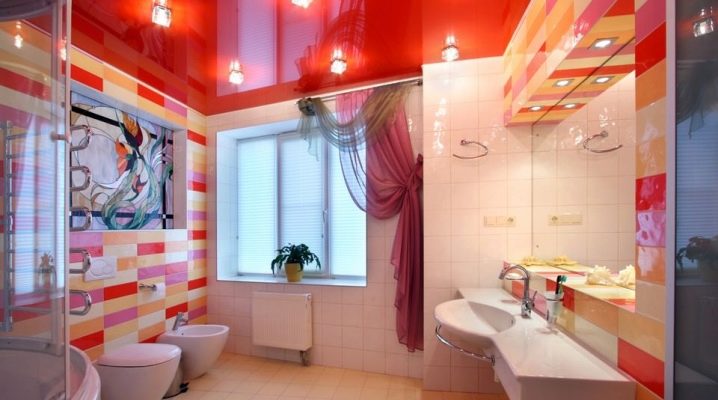
The modern design of the bathroom ceiling is different from what it was before. Today, more attention is paid to this, because manufacturers have significantly expanded the range of finishing materials. To better understand the possibilities of different techniques, it is worth taking a closer look at the options for decorating this special room of the dwelling.
Peculiarities
The main difference between the bathroom and other rooms in the house is the increased level of humidity. This is where a great deal of stress arises on any type of material used. Steam, rising, affects the surface, and sometimes even moisture penetrates to the base, causing condensation. As a result, the used cladding peels off, moves away from the surface. For this reason, no wallpaper can be used for the bathroom ceiling.

The same applies to the combined bathroom. A bathroom with a toilet does not always have a good ventilation system and well-thought-out communication systems. An enormous load is created on the coating, which sometimes deforms the material used. Appearance suffers, color changes, characteristic yellowness appears. Broken perspective also causes difficulties, which forces us to limit the design techniques.
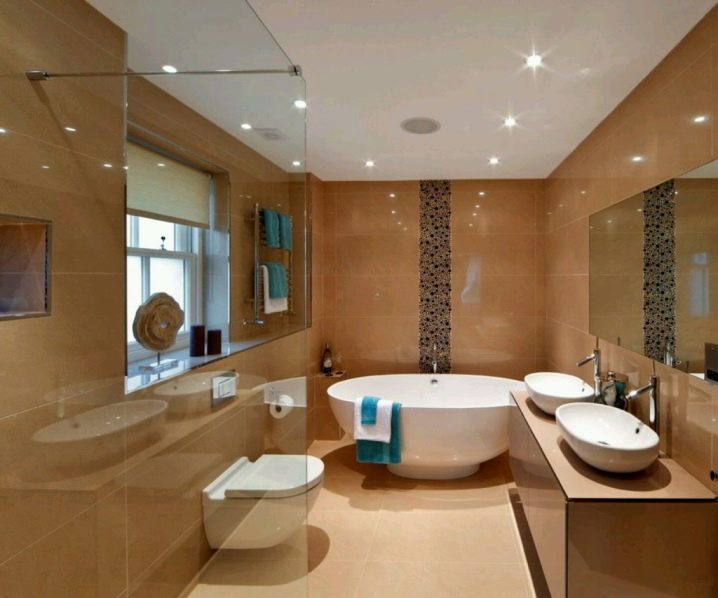
A modern approach to bathroom planning allows you to place it in the most unusual places. This can be the 2nd floor of a building, a closed veranda and even an attic. In the latter case, the design is complicated by the shape of the roof, which is both the ceiling and the walls of the attic structure. It will be more difficult to decorate the ceiling due to the angle of inclination, the presence of beams, rafter legs, windows.
Taking into account the conditions of the bathroom, experts have developed a different type of finish, which obeys a number of basic requirements. This allows the buyer to more accurately approach the purchase process, choosing the right material and a huge list. Materials can be of different composition, natural or synthetic origin, density and appearance. They have different installation technology, appearance and form of release. However, each of them must fit into existing standards and not allow moisture to pass to the enclosing structures.
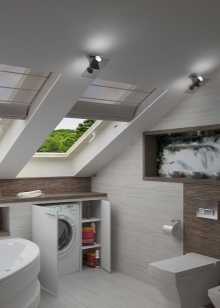
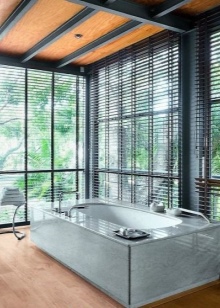
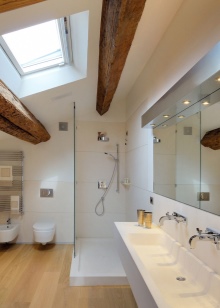
Material requirements for bathroom ceiling decoration
Moisture resistance | The ingress of moisture into the structure of the material and its accumulation is excluded. |
Strength | The material should not be damaged by accidental mechanical stress. |
Antistatic | The finish used should not become a medium for the appearance and growth of mold and mildew. |
Ease of maintenance | Any contamination should be removed from the surface, if possible, without special preparations. |
Environmental friendliness | This quality eliminates harm to the health of households and is especially important for allergy sufferers. |
Low weight load | The weight of the material should not create increased pressure on the carriers. |
Minimum reduction in wall heights | The less height the decoration conceals, the better. |
Abrasion resistant | Regular cleaning with household chemicals should not affect the surface of the material. |
Long service life | The ceiling has been made for many years.It should not involve frequent adjustments. |
Fire safety | Regardless of unforeseen situations, the material must not catch fire. |
Aesthetics | Attractiveness is one of the key factors. |
Availability | The priority is the material, the purchase of which will keep within the budget. |
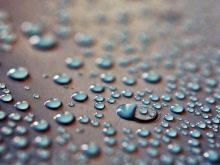

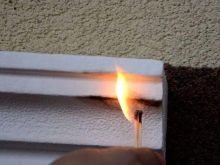
Unfortunately, not every type of material meets all the criteria at once. The main problem is moisture resistance. Whichever type of finish is chosen, it is water or steam that is the reason for the dismantling. Moreover, all used finishing materials have water-repellent properties. Trade marks at the production stage take care of this, improving the quality of the manufactured goods. However, no one is safe from leaks from the apartments above.
Advantages and disadvantages
The ceiling design of the bathroom has a lot of advantages.
- It changes the perception of a special room. Finishing is able to set the background to the interior, it makes the bathroom elegant.
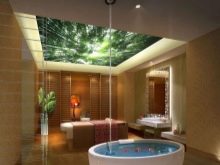
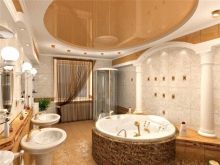

- This raw material is produced on modern equipment according to new standards. Due to this, it acquires high quality characteristics.
- Bathroom ceiling materials are available on the market in a wide range. Everyone can choose the option to their liking, taking into account the possibilities of the budget.
- The raw materials used provide for different methods of fastening to the floor. This is especially important in multi-apartment buildings with a high humidity coefficient.
- Most finishing materials provide for masking the base. They hide the defects of the ceiling (irregularities, potholes, chips, pits, cracks).
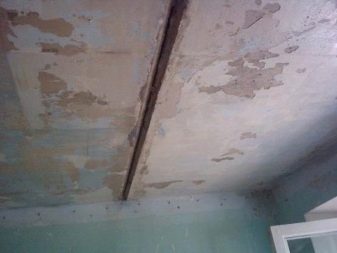
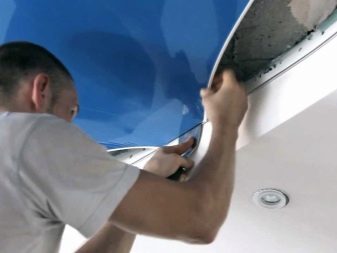
- Some systems allow you to get rid of the height difference. With their help, you can choose the height of the walls yourself.
- The finish used has a wide range of colors. Due to this, you can decorate the bathroom interior in any color.
- The finishing for decorating the ceiling differs in texture with the ability to imitate any materials. Its reflectivity is different and allows you to visually change the area of space.
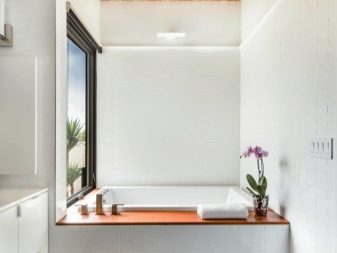
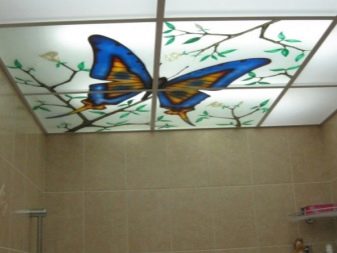
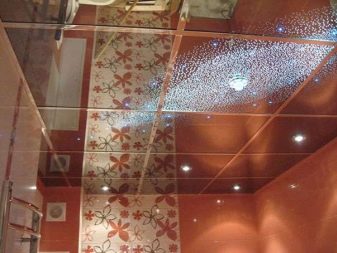
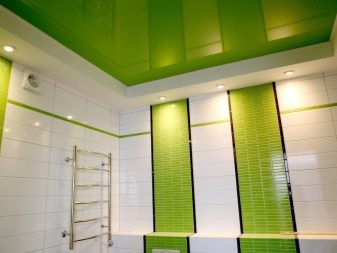
- The materials used allow the integration of various lighting systems. Manufacturers provide for safe components, so the fixtures will not melt the structure of the raw material.
- Ceiling cladding is appropriate for different interior styles. It can convey the characteristic features of any design through texture, color, lines, effect.
- Ceiling materials are harmoniously combined with each other. This allows you to zone the space if the style requires it.
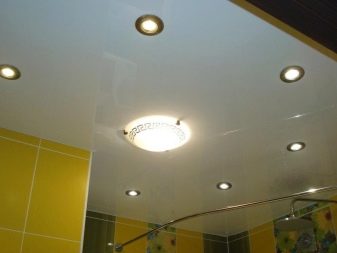
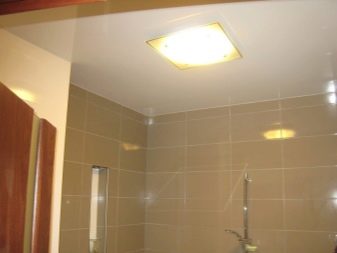
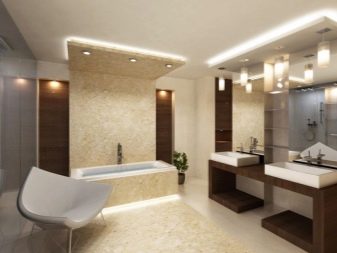
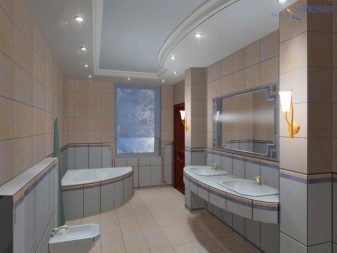
With a number of advantages, ceiling decoration also has disadvantages. In most cases, it requires preliminary preparation of the base. Without strengthening the structure, the coating will not be durable. The porous overlap is crumbling, the glued material will not stick to it. It will take some effort to level the structure with a penetrating compound.
Carrying out preparatory work requires time and the purchase of special raw materials. This may be the reason for contacting a specialist, because not everyone can build suspensions or a floating ceiling structure. In some cases, you have to move the wiring, which seems difficult for a common man in the street. Ceilings and hard-to-reach places are not without. This factor forces us to reconsider the choice from the available assortment.
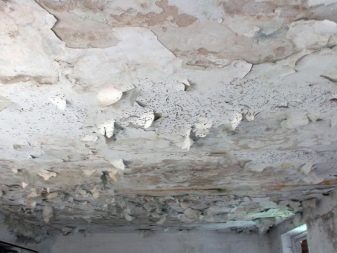
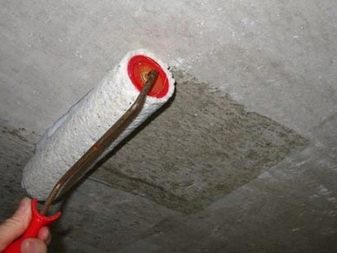
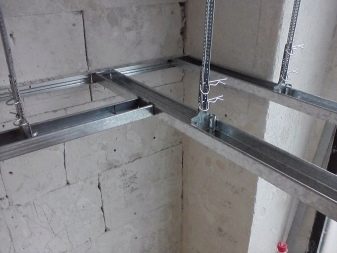
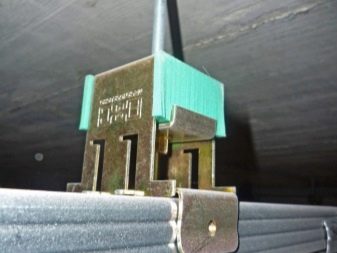
Buy material with a margin. This entails unnecessary expenses, but minimizes the factor of lack of finishing in the case of piece goods. Often it has to be cut and holes drilled for fixtures, which can cause breakage with an inept approach. The shortage can be complicated by the lack of the necessary material in the store: it can be sold out.
Materials (edit)
Different raw materials are used to decorate the bathroom ceiling.
- PVC stretch film;
- moisture resistant drywall;
- waterproof paint;
- plastic panels;
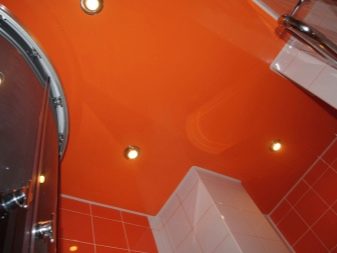
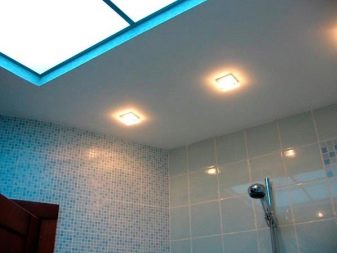

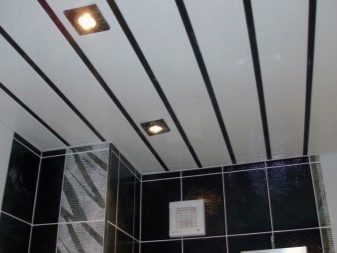
- ceiling slats;
- wall tiles;
- glass plates;
- metal cassettes;
- wood finish.

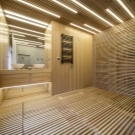
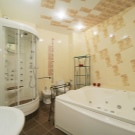
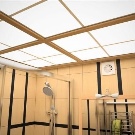
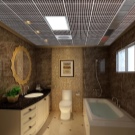
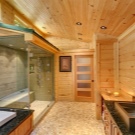
The use of plaster and fabrics to decorate a bathroom is a controversial issue. They allow water and steam to pass through. Not every plastering composition is appropriate in the design of the bathroom ceiling. Craftsmen do not recommend using fabric to decorate the ceiling, be it a stretch fabric or textile wallpaper.
Tiles should be used sparingly: they are sufficient for wall decoration. It visually reduces the height of the walls. However, the wall material is thinner than the floor tile, which reduces the weight load on the floor. Foam tiles are not suitable for cladding: they allow moisture to pass through, the fixing glue becomes sluggish.

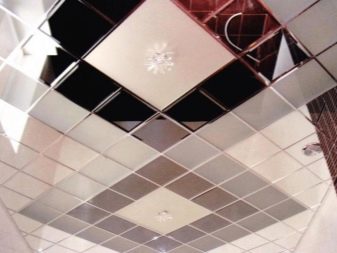
Painting is a budget option for decorating the ceiling. It is short-lived in comparison with panel coverings, ceilings made of metal (aluminum) or wood raw materials. Drywall cannot be called successful for small bathrooms, although it is impregnated with a special water-repellent compound. However, it is he who allows you to create multi-level structures. Therefore, it is most often used to decorate the ceiling.
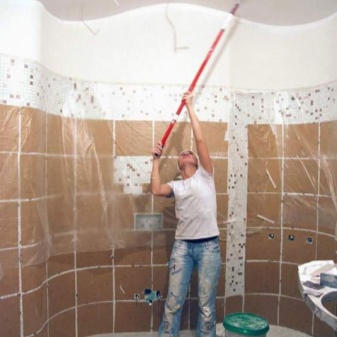
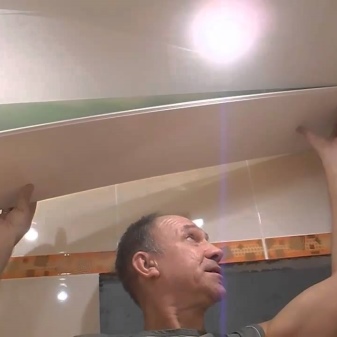
One of the best solutions is to use plastic. It is unaffected by water, steam and mold. It does not rust, like a cassette metal analogue, it is distinguished by its ability to imitate any kind of raw material, up to natural. The best options for its use are rack, panel and cassette techniques (strips, plates and square parts). It is more durable in use than analogue, say, from larch.
The film is comfortable with resistance to deformation. It is durable, does not change its original color. Differs in low weight, is able to retain water in the event of a leak from the apartment on top. However, in case of punctures or mechanical damage, it will have to be changed. Stylists do not recommend using mosaic for the ceiling: it is not combined with every wall decoration and stylistic solution of the bathroom interior.

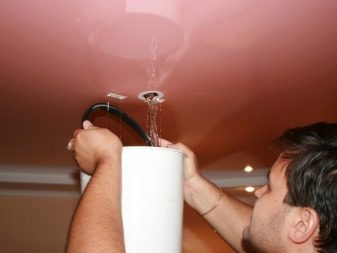
Single-level and multi-level structures
All existing types of design differ in the number of levels. Complex techniques are not accepted in the bathroom due to the often limited space. However, if the layout, the height of the walls and the area allow, different design techniques are used.
Single-level constructions are:
- film stretched over the frame;
- traditional painting;
- gluing wooden tiles;
- fastening panels, cassettes, rails;
- gypsum cardboard on a frame or hangers.

In fact, these are basic simple tricks. Due to the design, the ceilings look different. However, this is the same plane everywhere. If the design becomes more complex, it appears in it a design of a different height against the background of the main one - these are already two-level systems. If there are more levels, the design is called multi-level. Outwardly, this is a kind of cake made of boxes or shapes of different shapes, made in a combination of different finishing materials.
You can combine drywall and stretch canvas. The floating two-level ceiling looks good in a combination of drywall and plastic panels. The convenience of the rails and panels is the locking system of fastening. They are easy to install and can be combined with different types of built-in lighting.
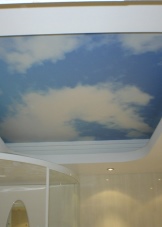
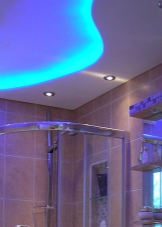
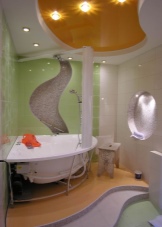

A multi-level system is provided due to the frame and cut-out figures from drywall. They are given the desired shape, thanks to the pliability of the gypsum board or the profiles themselves. Sometimes a box with a hole for the film is used in decoration, leaving space around the perimeter for cassettes or tiles. In each case, before the design, a sketch is created, on which all the nuances of the design are noted.
Lighting
Lighting plays an important role in ceiling decoration. It can make any design elegant. With the right choice, it emphasizes a certain area, it can be compositional, central and auxiliary. With its help, it is easier to arrange any selected material. However, the approach to lighting must be deliberate.
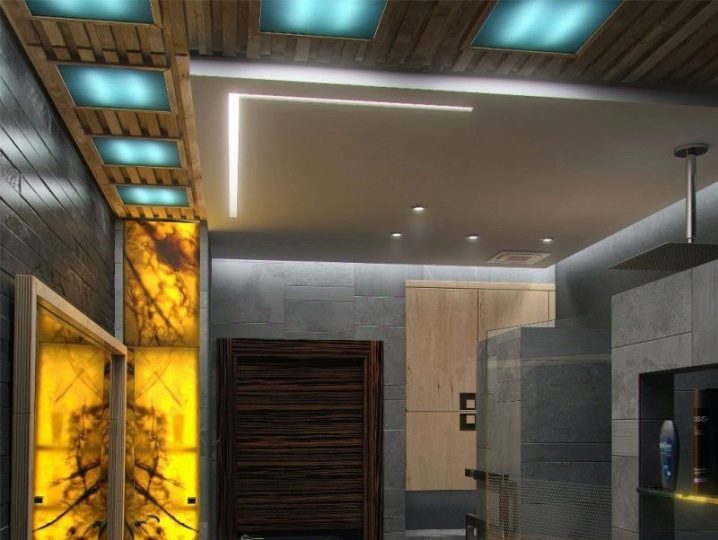
As the main lighting devices in the bathroom today they use:
- lamps on suspensions;
- near-surface panels of a geometric shape;
- point devices of built-in type;
- spots with a regulation system;
- flexible cord and tape.
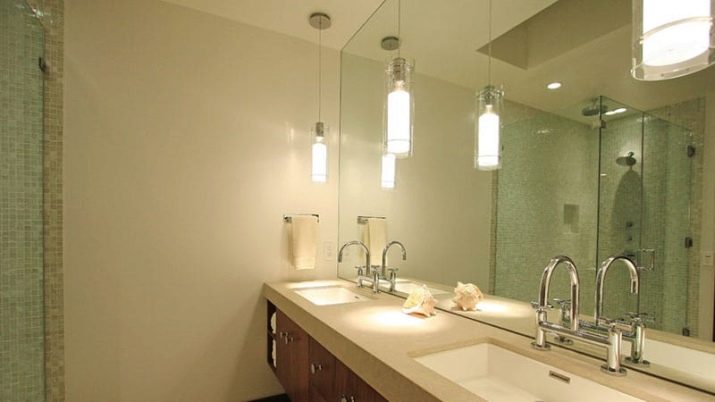
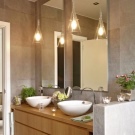
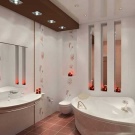

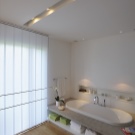
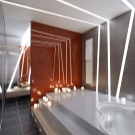
A distinctive feature of the lighting devices used is compatibility with each other. Depending on the design option, several types of luminaires can be located on the ceiling. For example, a circular center surface light looks good with built-in spotlights. At the same time, the structure can be decorated around the perimeter with a built-in flexible tape. The main thing when drawing up a design is to have a sense of taste, choosing an identical shape and decor.
A feature of using multiple lighting devices in a bathroom is the type of light sources used. These are LEDs that have low power consumption and size. They are safe, environmentally friendly, resistant to power surges, and have a wide color range of shades of the luminous flux. However, they do not give a scattered flux, their glow is directional.

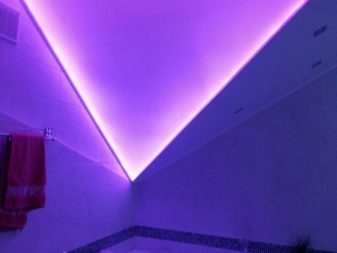

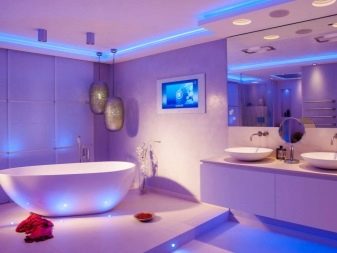
The choice of a central lamp will not solve the issue of dark spots and unlit areas of the bathroom: the lighting will be uneven. Therefore, you have to use several devices with equal steps. Or you can supplement the central luminaire with illumination around the perimeter of the ceiling. Sometimes it is built in along the contours of a box or curly lines, as well as in a niche reserved for floating structures.
All types of lighting fixtures used are subject to a list of requirements. Therefore, their placement is strictly defined. What matters is the height at which the light source is. The minimum indicator is about 2.3 m. In this case, the device must have a closed type of shade to prevent moisture from getting inside. Ideally, the light source should be protected from steam and have an enclosing decor. It should not heat up during operation.
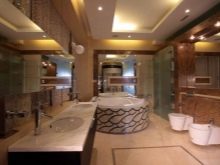
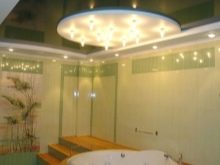
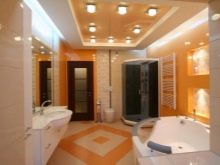
Design
Bathroom ceiling design solutions can be anything. They are based on taste preferences and the general style of the home interior. Stylists do not recommend opting for other styles. Abrupt transitions of styles of different temperaments can create an internal imbalance. Households will be forced to immerse themselves in a different atmosphere, which ultimately makes the bathroom uncomfortable.
The possibilities of finishing materials allow you to set the background for the interior in any style. Depending on this, you can choose classic, modern, ethnic, vintage or creative stylistic directions. Each branch of the design has its own characteristics. They can be shown through certain elements of the picture, panel techniques, contrasting inserts, additional decorations.
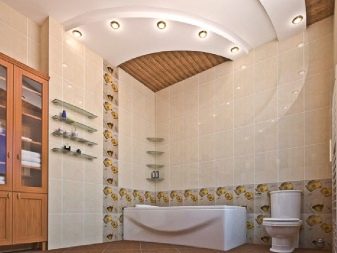

Classic
The line includes classics, neoclassics, classicism. All of them are united by a deliberate palace solemnity, characteristic elegance and ostentatious luxury. The differences between them are obvious: the embellishment of the modern approach is more restrained. This is a kind of evolution, adaptation to modern furniture, wall decoration, although the style's business cards remain.
Usually this:
- techniques for decorating the ceiling material with imitation of plaster moldings (tiles or decor in the area of the central lamp);
- various moldings, gilded baguettes;
- symmetry, a combination of geometric shapes with smooth lines.
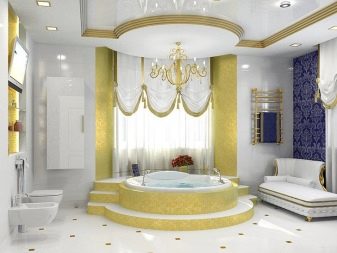

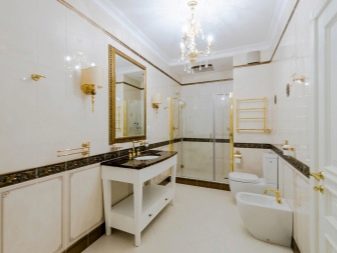
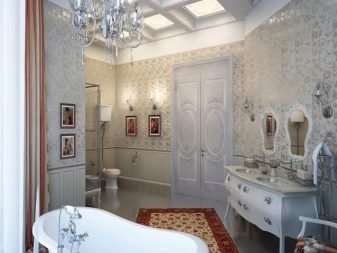
With regards to the modern approach, the emphasis here is on such techniques as:
- a combination of matte and glossy textures with highlighting them;
- the use of contrasts of white and beige;
- prevalence of white.
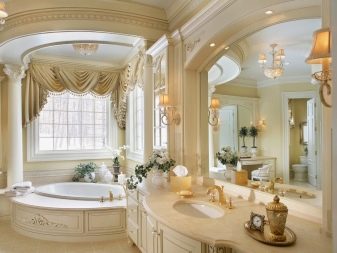
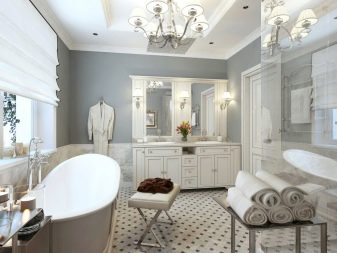
In the traditional version, the ceiling is made of film, plasterboard, panels with imitation gypsum and decorated with a chandelier on suspensions. However, this is more of a simulation, since the crystal is replaced by plastic, and the shades are closed. In the modern sense, chandeliers are replaced with light round structures on a short suspension.Their placement is possible only with high ceilings, short suspension lengths and the distance of the luminaire to the required distance from hazardous areas.
Modern
Decorating in the spirit of bygone historical eras is alien to modernist trends. It is important to show the texture and sometimes the synthetic base of the material used. Minimalism prefers a laconic canvas without embellishments, functionality is enough for it. Modern, Art Deco, Art Nouveau, Brutalism need elegance. There will be little monochromatic coverage. Possible glossy material with mirror inserts.
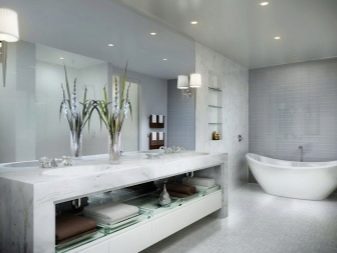
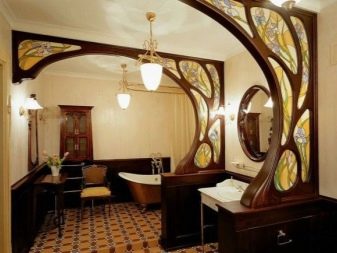
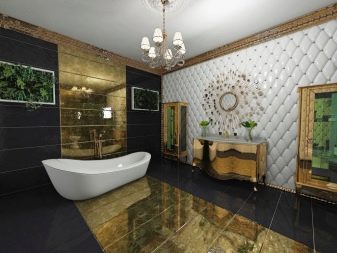
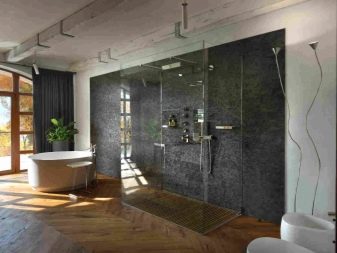
This is a gloss, stretch film with unusual inserts and prints, slats, cassettes, plastic panels, slats, cassettes, a luminous ceiling. Decoration of the ceiling material with lamps with a chrome surface. Sometimes it is important to show technology as well, for example, through a floating accent with the ability to turn. If it seems strange to some, others are sure of the need to choose such a design.
Ethnic
This thread contains the styles of peoples of different countries with their culture and traditions (for example, English Chinese, Italian, Arabic, Japanese, African, Greek style). The materials of execution are different (cassettes, slats, perforated tiles, drywall, sometimes paint, plastic panels). The stake is made on the ornaments inherent in each nationality. For example, for the English style, it can be a plastic wood-like ceiling tile.
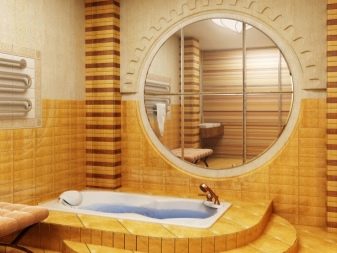
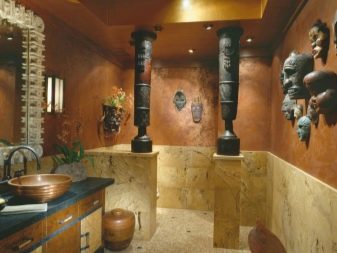
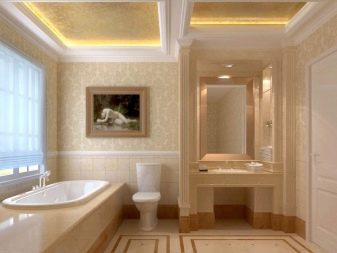

If you want to show the Greek direction, the ceiling can be laconic: a baguette with the desired ornament is enough. If this is an African style, you need a special flavor, bright colors. For Chinese designs, you can use the illusion of a floating ceiling with ribbon lighting, surrounding the accent with fanz-like decor. In ethnic areas, each element has a meaning that reflects the spirit of the era.
Creative
Such directions prefer a deliberately rough approach to decorating the ceiling. The priority is matte surface type, imitation of materials from industrial facilities and unfinished objects. These areas often do not need embellishments. Sometimes it is enough to deliberately make the ceiling look like concrete, hang imitation of communication systems on it.
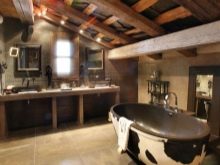
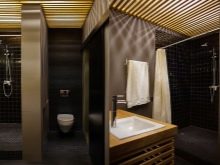
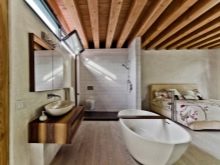
In other cases, the ceiling has beams. This is especially true when the bathroom is located in the attic. There is no need to change anything here: you just have to hide the wiring and perform waterproofing. Often, lamps (fans, lanterns, spots) become the accent of ceiling decoration. Therefore, the design is simple.
Vintage
The design options for vintage directions (rococo, vintage, provence) adhere mainly to the light colors of the palette. It is necessarily white, milky or ivory. The main rule is brevity. The priority is the matte texture of the material, its highlighting with gloss, a moderate number of lines, smooth shapes. However, in some cases, the presence of mother-of-pearl or pearl effect is possible.

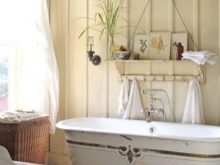
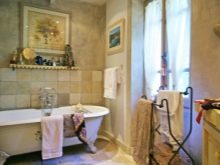
To decorate the ceiling, you can use the ceiling plinth, plastic molding. The slats-panels in the form of wood painted in white look beautiful. For more elegant directions, curved shapes, the use of drywall, and accentuation of the central lamp are acceptable. For such areas, it is worth choosing two-level ceiling design options.
Color spectrum
Bathroom ceiling colors are varied. To date, designers have uncovered the possibilities of each color. This allows you to move away from the usual standards and look at the possibilities of decorating in a new way. When choosing a color, the emphasis is now placed on the internal perception of the owner of the home. For this reason, dark tones, oddly enough, are given special attention. Dark gray, black, black-brown wenge, a mix of purple and black are in fashion.
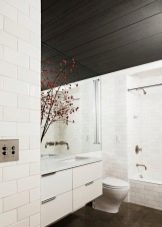

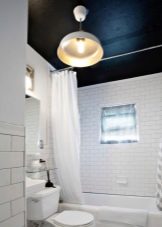

However, this approach is good where one person lives.If more than one person is using the bathroom, it can cause internal discomfort. You have to take into account the opinions of everyone and choose tones that are pleasant to everyone. In this case, materials of white, beige, milky, cream colors are often chosen for the ceiling. Warm colors contribute to inner harmony, they create an atmosphere of home comfort.
White is neutral and able to fill the space with light. It visually makes the ceiling higher and lighter. One of the successful solutions is the use of a glossy white texture. Often, white is complemented with gilding, silver or prints, which radically changes the atmosphere. It looks good with an olive, green, woody, mint companion.
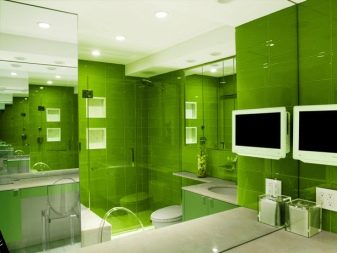
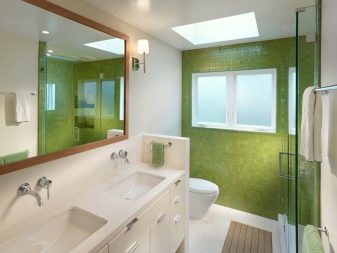
It is successful to use the texture for woody tones of light color or for painting. Shades of gray-beige bleached wood look stylish and expensive. No less successful is the use in the design of a light gray color with a coated surface, imitation of marble with beige stains. Among the bright contrasts, it is worth noting the dark blue color, which is used to realize the idea of a starry sky.

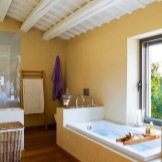
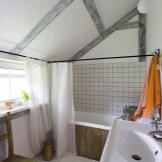
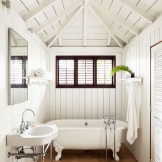
The tone used should be multifaceted. This means that the texture must consist of two or three tones, possibly with an ombre effect or smooth infusions into each other. The combination of bleached textures with white is appreciated. Sharp contrasts of light tones with wine, black are a thing of the past. It is important to show harmony and lightness. To soften, try to use related shades.
How to do it yourself?
Decorating a bathroom ceiling with your own hands is not as difficult as it might seem at first glance. The amount of work depends on the type of material used and the method of fixing it. A prerequisite for frame methods is waterproofing. It is laid between the skin and the base.
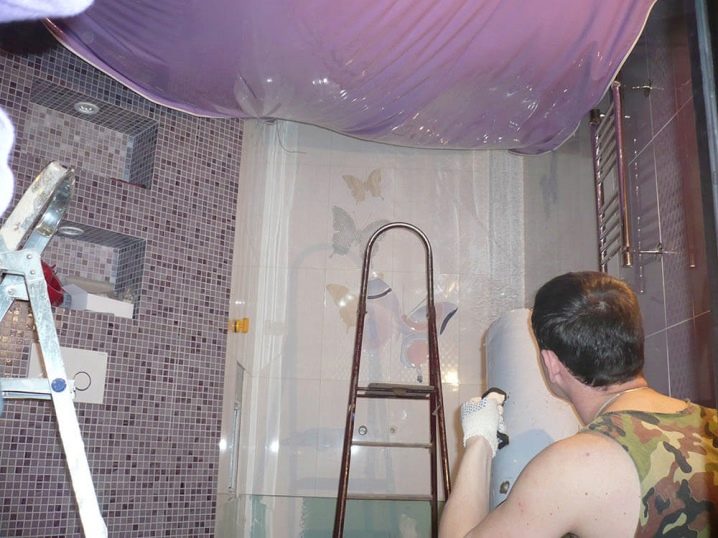
Painting
The easiest way is to paint. The surface is first prepared: cracks are covered, bumps, chips and potholes are removed. It is necessary to remove everything that creates the uneven effect. After that, the base is treated with a primer to strengthen the walls. Penetrating inside, it binds dust particles and microcracks. After it, the surface is treated with a cement-based plaster, then polished. The paint is applied twice so that the color is clean and the surface is painted with high quality.
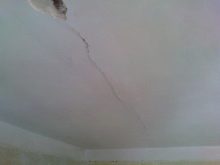
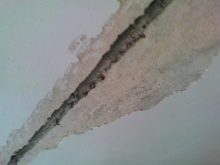
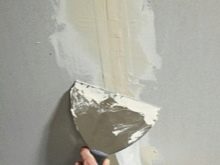
Ceiling tiles
If painting is too easy for the ceiling, it can be covered with plastic or wood-based ceiling tiles. For this, use a special glue. Preliminary preparation of the base, calibration of tiles is carried out. Despite the assurances of the sellers, they differ from each other, which is the reason for the gaps. On the back of the tiles, glue is applied (5 - 9 points), then they are applied to the ceiling and pressed. When the ceiling is fully pasted over, a ceiling plinth (baguette) is attached around the perimeter, leaving a gap of 8-10 cm for embedding the tape.

Panels and slats
Finishing the ceiling with panels requires the construction of a frame. It is made from aluminum profiles and hangers. The profiles are fixed around the perimeter with dowels, connected, covered from below with a ceiling plinth. After that, the panels are inserted into the plinth, not forgetting to take care of the hole for the lamp in advance. The last panel is sawn lengthwise and snapped into the grooves of the baseboards and the previous part. Ceiling decoration with slats is similar in technology to panels.
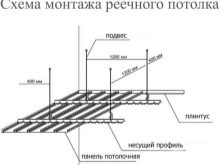
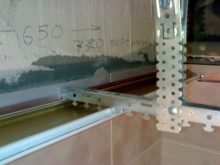
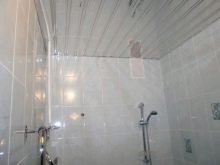
Stretch canvas and drywall
Installing drywall and stretch film is somewhat more difficult. A frame is created for the stretch fabric. These are profiles that are attached around the perimeter with special fasteners. After that, the room is heated to a temperature of 60 degrees using a heat gun. The film is fixed in the corner, then fixed in the opposite corner, then in the two remaining ones. It is pulled up, moving from the corners to the center. Excess material is cut off.
Installation of drywall is also not complete without a frame. The most common option is a harness. A base is prepared, suspensions of the same length are screwed into it. A frame is constructed, which is connected to the suspensions. For fixing, special fasteners are used. Gypsum fiber sheets are cut and folded according to the design, after which they are attached to the frame.
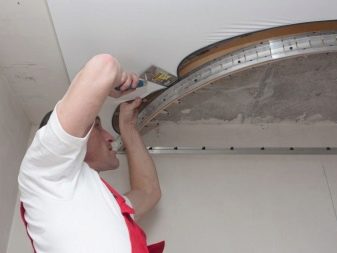

Cassette
To sheathe the ceiling with cassettes, it is necessary to build a metal frame in the form of cells. Preliminary calculations are carried out, the location of the parts is marked, ensuring that each square cassette falls into place. After the frame from the profiles is ready, decorative cassette panels are inserted into it. You can decorate such a ceiling in the bathroom using aluminum varieties, plexiglass, acrylic, mineral and galvanized options.

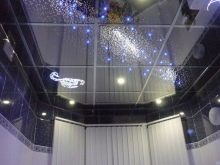
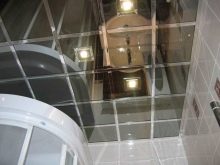
Advice
In order not to hesitate when choosing a material for decorating a bathroom ceiling, there are a few helpful tips to keep in mind.
- The dark color of the finishing material for the ceiling will visually reduce the height of the walls, the light one will make them higher.
- When choosing paint for the bathroom, it is worth giving preference to coatings with silicate compositions. They resist the formation of mold.
- Tiling can be chosen exclusively as an accent shower. The drawing should be chosen light, in natural colors.
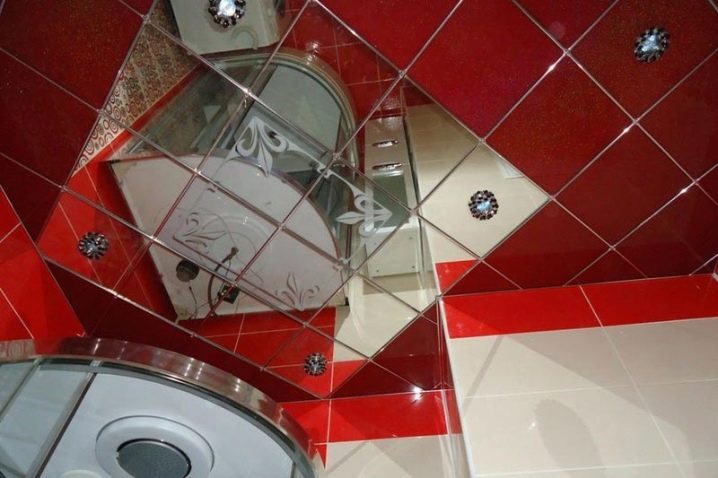
- When choosing aluminum rails, you should pay attention to the protective layer of varnish or paint.
- The cassette ceiling is convenient for easy access to the interior space when needed. In this case, individual panels can be replaced with built-in luminaires.
- When choosing plastic panels, it is better to choose a dense material of sufficient width. The docking technology must be seamless.
- For the construction of the frame in the bathroom, a galvanized metal profile is needed. A woody analogue can deform from constant exposure to moisture.
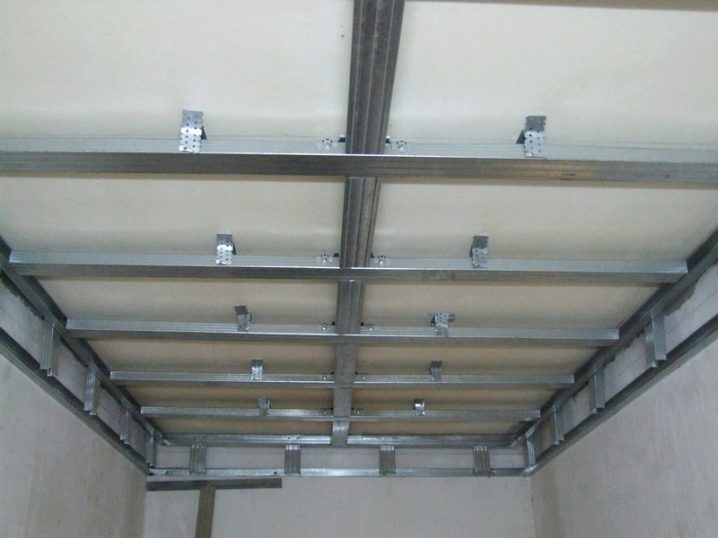
- Installation of glass for a ceiling structure is within the power of an experienced craftsman. During installation, you need to cover it with a special protective film.
- Mirrored inserts in the design are appropriate in a small volume. With their abundance, an internal imbalance will be created.
- When choosing a tree as a ceiling covering, it is worth giving preference to larch, oak and hornbeam. Their percentage of deformation is less in comparison with other analogs.
Beautiful examples in the interior
You can get ideas for inspiration for decorating a bathroom ceiling by looking at the sample photo galleries.
- Indian theme with unusual ceiling design and beams.
- An unusual approach to design using the backlight built into the stretch film.
- An example of the harmonious use of a mirror insert in the form of plasterboard-based cassettes.
- A creative design technique using wood and beams with an aged surface effect.

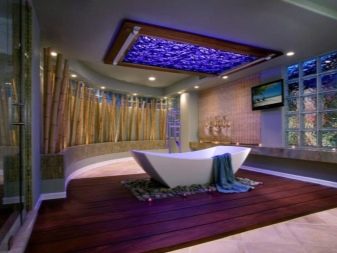
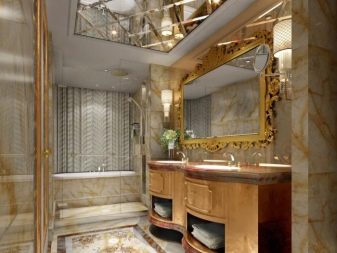

- The use of a wooden texture against the background of a stone wall decoration, a pendant lamp and built-in lighting.
- An interesting solution using plastic panels with a laminate effect looks impressive against the background of wall slats.
- Unusual design of a two-level structure in the form of a polyhedron with a ceiling decoration with a creative chandelier.
- Multilevel ceiling overlap above the bath bowl, use of a geometric pendant lamp, accentuation of the bath area.
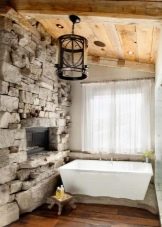
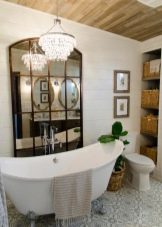
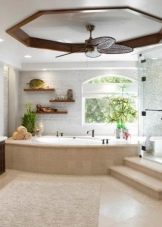
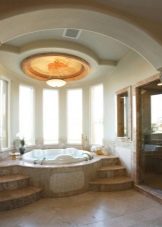
- An extraordinary reception in the form of a niche, allocation of a functional area with spots with adjustable tilt angle.
- Using stretch film with fiber optic filaments. Designed in neutral colors.
- Highlighting the shower enclosure with a separate lighting strip such as RGB in a blue tint. The presence of built-in chiseled lamps.
- Cassette ceiling with light panels. A harmonious solution to the bathroom interior in neutral colors.
- Accentuation of the shower cabin with tiles, the presence of a hood. The main part is finished with plasterboard.
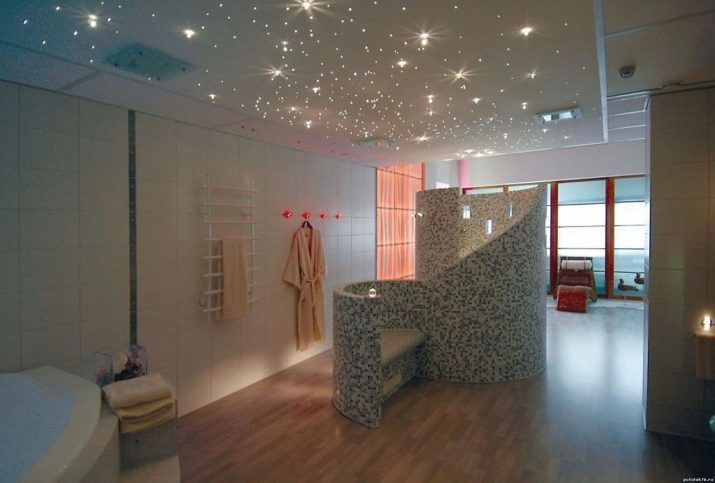
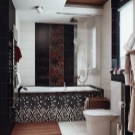
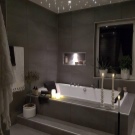
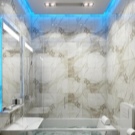

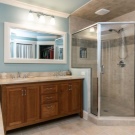
The intricacies of choosing the design of the ceiling in the bathroom are described in detail in the video.













Thanks for the helpful and interesting article!
The comment was sent successfully.